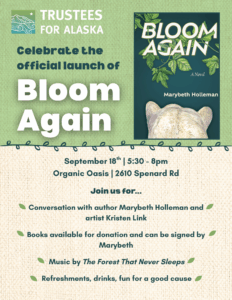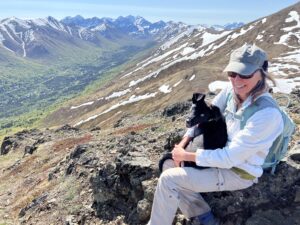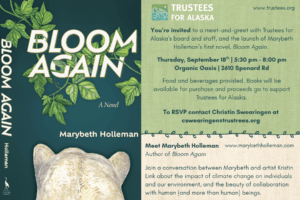
Bloom Again—a book about us
By Dawnell Smith
Marybeth Holleman found herself taking a leap of faith. The longtime writer of poems and essays in books about Alaska and nature shifted to fiction. She blames her dad for planting the seed, and thanks that seed for her imaginative bloom.
“Many moons ago when we were talking about my first book, “The Heart of the Sound,” he did that thing people do to writers and asked, ‘What are you working on now?’, and I stumbled, because I was still caught up in this first book, you know, and then he said, ‘Why don’t you write a novel? Everyone loves to read novels.’”
It’s true. People love making, reading, telling, and hearing the stories. Perhaps we participate in fiction differently than other genres because we employ our imaginations more freely, and break through the walls to our hearts more fully.

Come to Trustees’ “Bloom Again” event with Marybeth on September 18 for food, drinks, books, and conversations!
Whatever the case, Marybeth, ever the taker of her dad’s advice, wrote a novel, “Bloom Again,” (out in September) that tells the story of old friends and new ones, and of taking leaps of faith and taking on the big challenges of our time, like climate change and its direct impacts on living beings and places from the Arctic to India. It’s a book about the living communities around us, human and more than human, and it’s a book about us.
“I just started with these two characters, Astrid and Elyse, each of whom represent a way my life could have gone,” said Marybeth. From there, she asked, “What if?” again and again, allowing the characters to tell their stories.
In other words, she expanded from the old adage, “write what you know,” to, in her own words, “how about, start with what you know, then meander off wherever you want to go, or wherever your characters take you.”
The writing became like a meditation, she said.
Letting “what if” drive the imagination is also a rebellion of sorts, Marybeth’s leap of faith—a way of beachcombing or mountain wandering that leads with observation and listening, wonderment and curiosity, and most of all, hope.
Writing on climate and the overlooked
Transitioning from writing nonfiction and poetry to writing a novel didn’t happen overnight. That initial “dad” conversation took place almost 15 years ago, and there were other influences, too, like a conference on literature and environment that nudged Marybeth’s thinking to that edge of action.
She recalls listening to Ann Pancake talk about her novel, “Strange as This Weather has Been,” with its focus on the catastrophe of mountain top coal mining in West Virginia, and then considering how Barbara Kingsolver brought red wolf reintroduction into her book “Prodigal Summer.”

Marybeth looking over Long Lake. Photo by Rick Steiner.
Marybeth realized she had reached a dead end in writing essays about climate change, because people had tired of reading about it and feeling depressed or even hopeless.
With fiction, you can “bring in big scary vast decentralized ground-moving things like climate change,” said Marybeth, and “the reader gets vested in the characters, and in their story lines, and their hearts are opened more, so that you can reach them at a different level than, say, nonfiction.”
Marybeth also devotes her work to what’s really happening on the ground, the facts and wisdom inside stories. More than ever, adhering to truth matters. Though she hasn’t been to every place depicted in the book—like Siberia, for example—she has traveled to many villages and landscapes in the Arctic, has read widely and also specifically to her characters’ interests, and researched the places, ideas, living beings, and people important to her characters and story.
“I wanted this book to include places and beings who are often overlooked when we talk about the effects of environmental destruction,” she said. “I wanted to show the expanse of climate change; how it knows no boundaries; how it’s harming all of us.”
For example, she learned about quantum physics and the physics’ theory of everything to make sure that an important figure for one of her characters rings true to life. She drew on her own experiences in Alaska and North Carolina and India as well as conversations with those who have lived experience with places and cultures.
“The book is entirely scientifically and realistically accurate,” she said. “Though it’s fiction, everything in the book either has happened, is happening, or could happen. For example, the part that’s set in India is based on time I spent there, on people I met there, and on reading I did before and afterwards. Learning, for example, about the man who, as a boy, started planting bamboo to keep rivers from flooding and killing snakes—I took off from that very true and amazing story to include a character who does these things, and to show the power of a single individual’s devoted, focused work.”
The call and response to crisis: together, always
One theme that interests Marybeth is collaboration among and between living beings—people and other people, people and animals, animals and animals, animal beings and wildflowers, trees, berry bushes, grasses, and so much more. And all living beings with the mountains and rivers, the oceans and valleys, the pastures and canyons, and so on.

Marybeth and her dog Xena Magnolia at Arctic Valley. Photo by Rick Steiner.
“Human relations with the beyond-human world is a constant theme in all my work and thinking and yearning,” she said. “Both the main characters, Astrid and Elyse, experience moments with the beyond-human world that are like what Virginia Woolf called ‘moments of being’ or Mary Austin called ‘flashes of mutual awareness.’ Moments when the veil between us and them, between my skin and this birch bark, drops, and there’s a deeper awareness, a feeling of connection and communion.”
Many people can recall these moments, and many live for them, she said. It’s what she’s been saying in all her writing. “We’re only going to be able to sustain life on Earth if we recognize, value, and participate in the vital, necessary, integral, intricate relations with all beings, and to do this, we have to be able to listen to more than just human voices.”
To bloom again can mean to reclaim purpose after a life of obligation and responsibility, to mend and flourish after decay or catastrophe, to incite collaboration, to shift a crisis into a question that blooms into new ways of thinking, doing, being.
It can mean all of that at once and put you out on an edge where you can see more clearly and choose your next step, because the world surely asks something of you.
“Let’s say you’re a comfortable, fairly successful middle-aged woman whose life appears right on track,” Marybeth said of her two main characters, of women she knows, and even, perhaps, of herself. “Say a series of chance encounters and events outside of your control throw you off the track. Say there’s also an underlying restlessness, call it a midlife crisis, call it post-menopausal zest, call it the second coming-of-age, that surges you into unfamiliar, and uncomfortable territory. What do you do? How do you respond?”
What if?
 Trustees for Alaska invites you to the official launch of “Bloom Again” by Marybeth Holleman, who will read from her work, sign books, and have a conversation with artist Kristin Link about collaboration with human and more than human beings.
Trustees for Alaska invites you to the official launch of “Bloom Again” by Marybeth Holleman, who will read from her work, sign books, and have a conversation with artist Kristin Link about collaboration with human and more than human beings.
Also, meet and mingle with Trustees for Alaska’s board and staff! Join us at 5:30 p.m. September 18 at Organic Oasis.
Food, beverages, and book drawings provided. Open to the public. Find out more here.
Marybeth Holleman is a writer who lives in Anchorage, Alaska. You might bump into her and her new and rowdy puppy Xena Magnolia on local trails. Her work includes a book of poetry, “tender gravity,” and a memoir, “The Heart of the Sound: An Alaskan Paradise Found and Nearly Lost.” She is the co-author of “Among Wolves: Gordon Haber’s Insights into Alaska’s Most Misunderstood Animal,” and co-editor of “Crosscurrents North: Alaskans on the Environment.” She’s also co-editor of the forthcoming “Alaska Literary Field Guide.”
Her first novel, “Bloom Again,” comes out on August 15th. Find out more about Marybeth here.


